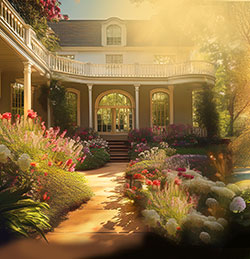Our surroundings affect our moods. Sometimes all you need is a little refreshing change in your surroundings, and you can feel renewed. We all want to update our surroundings to begin the new year.

Let’s renew!
Yes, it’s time to look at our own nests and see how we can make them more spring-like and cheery.
With the drabness of winter easing off, looking wistfully out a window at the buttery sunshine progressively getting a more yellowy tint, we start to think of tidying up or beautifying our surroundings indoors and outside in our gardens and lawns.
Have a look around and think about what would make you smile. Perhaps it is as simple as placing a pot of daffodils on your kitchen counter or office desk.
Add Something Fresh
Spring is a great time to refresh your home or office and create a new, inviting space for yourself, your family, or your colleagues.
Bringing in some fresh flowers or plants can green up your surroundings. Besides, a trip to the florist would be a lot of fun. Did you know that taking a whiff of daffodils or hyacinths is said to be beneficial?
The fragrance of many flowers triggers our cognitive capacity, eases blood pressure, and is mood-lifting. I know you have breathed in some pleasant-smelling floral scents and were totally awed. Certain chemicals in the fragrance of the flowers interact positively with your brain. So next time you are near some flowers, reach over and breathe in! Just a slight scent break can relieve tension and make you feel better.
Rearrange
Making a small change, like clearing, decluttering, and rearranging your desk at work or tidying up around the house, can give you a new feel.
Try changing chairs or moving seating arrangements around to create a new dynamic. Did you know that facing seats toward others can give a different feeling than sitting side by side?
Some years ago, I talked with clients and interviewed various people in my work. The office seating was such that we would always sit opposite one another. This seating style is often intimidating and sometimes feels adversarial, as when an employee meets to discuss an issue with a boss. This worked out well, but I did notice that there was often a feeling of tension. It took a while to warm up the conversations.
Since the object of our interaction was to develop a trusted working relationship for a project, I wanted to find a way to create a more welcoming atmosphere at the outset.
I studied charts and statistics for interior design and how flow creates an atmosphere. As a result, I changed the seating so that we were at right angles to each other. This was still a formal and respectful seating arrangement. Still, it was halfway to sitting side by side, which is how close friends often sit.
This small change made clients feel more comfortable, and my sales increased.
Color or Green Up Your Space
Winter days can be grey and drab despite a few sunny days, the glistening snow, and even the colorful holidays cheer us. However, as the sun seems to lessen, we lose vitamin D. Although the sun remains the same from one season to another, the earth’s angle to the sun changes, and the sunshine we receive is lessened. This is the same for plants and other living things. You can notice the birds start singing in spring as the earth turns a little more towards the sun. Plants feel the added warmth and come alive with color.
Adding splashes of color to your surroundings can make you feel more vibrant and energized. Changing throw pillows, adding seasonal artwork, or changing a table or desk setting to include more color can brighten everyone’s mood.
Change or Add Lighting
Good lighting is essential. Consider updating your lighting fixtures and replacing cool light bulbs with warmer ones. Place some new task lighting on your desk to improve your work environment.
Table lamps are an easy fix. They are easily moved to create a new look when you choose a table lamp with a spring lampshade that can be switched out for different looks depending on the season.
Add Personality and Connection
When you place family photographs, some images of memorable events, artwork by someone you know, or other collectibles that inspire you, it can make you feel happier, and you will be more productive.
Incorporating these ideas into your home and office allows you to create new and refreshed spaces for the spring season. A spring theme picture frame and your family photo inside can add to your decor. Small picture frames are easy to change to create a spring look and add your personality to a room.
Regenerate Your Outdoors Too!
What is your garden or yard going to look like this year? Start by looking at pictures in magazines to get ideas. Attend a garden or Home Show in your area.
Planning a vegetable garden, flowers for your front yard, or some potted plants on a balcony can be a rewarding promise for you to enjoy this summer. Remember your surroundings, both indoors and outside. You can be a minimalist and have a streamlined modern look, a splash of color here and there, or use only foliage with a pallet of various shades of green. Or you may have a lot of space to fill, and finding the maximalist approach with a large garden and flowers that bloom in turn is the one for you!
A Few Gardening Basics to Spruce Up Your Yard
Outdoor lighting can create a warm and inviting atmosphere, creating ambiance and highlighting key features in your yard. The use of Low-voltage LED lighting makes it energy-efficient. Installing motion detector lighting in strategic spots can make it easier and safer to use pathways and act as an alert.
Adding a water feature to your yard can create a sense of tranquility and relaxation. A water fountain or bird bath can give you hours of watching pleasure in your back garden.
Landscape professionals can install natural-looking water features like small ponds that blend seamlessly into the surrounding landscape.
Using native plants in your yard can help support local ecosystems that serve as naturalistic, low-maintenance garden designs.
Professionals can plan a food forest garden around your preferences. Why not plant a small food forest garden if you have the space? Not only can it provide you and your family with edibles, but it also becomes a natural habitat for some wildlife. You might want to attract a specific type of butterfly, like the Monarch, Eastern Tiger Swallowtail, or another butterfly native to your area. Perhaps you enjoy Humming Birds. Whatever you enjoy, there are natural habitats you can enhance.
Please Note: When planning an extensive garden project or Food Forest Garden, make sure to check the Zoning Rules in your town or city. Homeowners Associations can also have particular rules in place for residents.
Vertical gardens are a great way to add greenery to small spaces and create a stunning visual display. Using natural materials, such as wood and stone, gives your yard a rustic and earthy feel.
Garden Lighting can be beautiful and whimsical, offering a way to light up a path and make a walkway safer.
Some vegetables are also great in vertical plantings. Cherry Tomatoes can grow in pots, and climbing beans, such as the Scarlett Runner variety, not only bear interesting dried beans to cook but also attract honey bees and butterflies.
Comfortable, oversized seating is excellent for relaxing and unwinding after work. It does take a bit of work to look after a yard, but why not make it contain some elements that make you feel like you are on vacation once you finish work? A hammock can be just the thing! Outdoor seating areas create inviting places to entertain, sit, and read a good book.
Fire pits, BBQs, and outdoor heaters allow you to enjoy your yard. You might even decide to have a Staycation this year.
Use sustainable materials like reclaimed wood and recycled plastic in your yard to lessen environmental impact. More sustainable materials are used in outdoor furniture, fencing, and decking. There are new and stylish outdoor furnishings that last much longer than previously, and some have the possibility of double usage in an indoor space.
Planning To Create A Garden Or Enhance Your Yard
Here are some items you might need.
- Gloves: A good pair of gloves can protect your hands from dirt, thorns, and other hazards.
- Trowels: A hand trowel is a small tool with a pointed end used for digging small holes or planting bulbs and seedlings. Trowels also come in a variety with some tongs to break up soil or remove weeds around plants easily.
- Pruning shears: These are used to trim back plants and trees, remove dead or damaged branches, and shape shrubs and hedges.
- Rakes: There are various types of rakes depending on their usage. Some rakes are for leveling soil and removing debris. Some rakes have tongs that are used to weed around garden plants. Although Leaf Blowers are helpful, a good old-fashioned Leaf Rake is quite useful, especially once you have piles of them to bag up.
- Watering can and a Hose: You’ll need something to help water your plants. A watering can is handy for plants on your deck or balcony. A long hose on a rollable stand is excellent for larger gardens and helps fill your watering can without traipsing through the house.
- Soil: Good soil is the foundation of any successful garden. Nurseries offer bags of soil especially for flowers or roses, while others are specifically formulated for vegetables. There are lawn and tree formulas, also since different plants require alternate levels of nutrients.
- Fertilizer: To help your plants grow strong and healthy, you may need to use fertilizer to provide them with essential nutrients. Many ideas can help feed your garden soil. It all depends on how involved you wish to become. These days, we are all interested in knowing more about how to be good stewards of our environment.
Vermiculture, or keeping composting worms such as Red Wigglers, is a fun way to help, and kids may find it a great science project to talk about in school. With a worm bin in a shady spot in your garden, you can recycle all of your kitchen vegetable and fruit waste, plus cardboard boxes and junk mail, turning it into Worm Castings that fertilize your plants. - Seeds or plants: You can get a seed catalog in winter or early spring and plan your garden and the seeds you will need to order. Or you can visit a garden supply, or nursery, or shop online. Increasingly, there is more choice and variety online.
A packet of seeds is also the perfect gift to say Thank You. Or give them as a hostess gift or to cheer someone. - Flower Pots and Containers: These come in a large variety and help you plan where to put your containers. Using flower pots and containers, you can plant cute gardens in some smaller yards. Old chairs and other objects can be used as plant holders, giving your garden a charming vintage look.
All it takes is imagination and a little hard work.
Last year I planted a small container garden in our tiny backyard. It was amazing to go out each day and pick a handful of fresh cherry tomatoes, greens, lettuce, squash, and nasturtium blossoms. Every day we had something different to eat from our garden. Adding just one homegrown thing to your plate is a healthy thing to do. It also gives you exercise in the fresh air and sunshine besides offering a quaint spot to read a book and enjoy the butterflies that happen by.
More Things You May Need To Buy
- Sun Protection: You’ll be spending a lot of time in the sun, so ensure you protect yourself with a Sun Hat and good sunscreen.
- A Cart or Wheelbarrow: Use the right equipment for moving heavy bags of soil, plants, or other materials around your garden. An old-fashioned wheelbarrow can help a lot or be too heavy or not useful enough in your space. I find a four-wheel cart works best in a smaller yard.
Watering Your Garden
Your garden may need daily watering, depending on the climate and rainfall in your area. The type of soil can also determine how much watering is required. Here are some planting tips.
Drought-tolerant plants: If your climate is dry and hot, you should choose plants that do better with less water. Some drought-tolerant plants include succulents, cacti, lavender, and rosemary. Researching what plants are native to your area will help you decide what to plant.
Group plants with similar water needs: Create separate areas for plants that enjoy a lot of water and other areas for plants that like to be in dry soil.
Mulch Plants: Mulch can help retain moisture in the soil and prevent evaporation. Spread a layer of mulch around your plants to help the soil retain water.
Install Drip Irrigation: This is a water-efficient method that delivers water directly to the roots of your plants. This method uses less water than traditional watering methods and can be set up to run on a timer.
Self-Watering Containers: Self-watering containers have a built-in reservoir that holds water for your plants, which can be a great solution for containers or small gardens.
Collect and reuse Rainwater: Collecting rainwater in a rain barrel or other container can be a great way to water your plants during dry periods. You can then use this water to irrigate your plants when rainfall is not as prevalent.
7 Ideas To Help You Make a Prettier Garden
Plant a Variety: Choose different shapes, sizes, and colors of plants to create a more visually exciting display. Mix tall plants with trailing ones, and choose plants with colorful flowers or foliage.
Plant Flowers and Shrubs that attract Pollinators.
Use a variety of Containers: Mix different shapes, sizes, and types of flower pots, troughs, lined baskets, and hanging planters. Arrange your containers artfully to create visual interest and add depth to your display. Find unusual items that can be used as planters. An old pair of worn-out boots can be a cute planter. Deciding on a theme for your garden displays will give your garden a coherent look. You can choose objects and containers with an upscale urban look or resemble a farm or cottage garden style.
Plan the Color Scheme: Choose plants and containers that complement each other in color. You could go for a monochromatic look with plants and containers in shades of the same color or choose complementary colors for a vibrant display. A good tip is to use a color wheel to select colors. After all, you are the artist in your garden, and the plants and flowers are the paints in your pallet.
Add Texture: Mix plants with different textures, such as plants with fuzzy leaves or spiky foliage, to create a tactile display that looks as good as it feels.
Garden Accessories: Small garden sculptures, benches, or unusual items can be used to accessorize your garden. An old door no longer useful in its original place can be re-purposed as a trellis for climbing plants. Two old doors, one on each side, fastened together to make an archway over a garden path with climbing roses can be beautiful. Decorative rocks painted by your children will add personality and be special reminders to your garden.
An old metal watering can that can no longer hold water can be used as a planter and mounted so that it has flowers flowing from its spout rather than water. An old bicycle can be painted and artfully propped up to form a fence marker as well as provide a place for climbing vines to hang onto.
Plant Maintenance: Keep your plants healthy and well-maintained. Deadhead old blossoms, and prune them as needed, and remove dried-up leaves. Fertilize your plants as needed. Use Worm Castings if possible. A healthy and vibrant plant will add to the overall beauty of your garden.
Education: There is a lot to learn about gardening. It can be a life-long and rewarding activity. Remember this old saying, “If you want to be happy, plant a garden.”
There are many books on gardening that will help you at your local library or bookstore. Below is a brief suggestion of some titles that you might like.
- Vegetable Gardening for Beginners, by Jill McSheehy -A Simple Guide to Growing Vegetables at Home.
- Grow Your Own Medicine, by Ava Green and Kate Bensinger—a Beginners Handbook for the Self-Sufficient Herbalist.
- Lasagna Gardening for Beginners, by Eric Goldinger, The Enlightened Way to Compost and Garden at the Same Time.

for promoting the above-mentioned books or authors. The above Illustration by: Trina
Relatives or friends will be happy to share some of their gardening experiences with you. Whenever I plant tomatoes, I think of an uncle who was proud to show me how he planted his prize-winning tomatoes. He would take a tomato plant, nip off the bottom two branches, and lay the tomato stem and root into a trench he had dug. He then covered it up with only the top branches showing out. This allowed a thick stalk to grow and support the heavy beefsteak tomatoes.
Before you know it, you will be lounging on a hammock between two trees, reading a good book, and snacking on some delicious fresh strawberries you’ve just picked.



